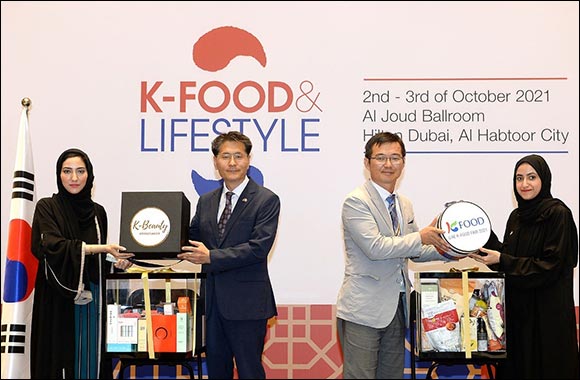Korea Agro-Fisheries and Food Trade Corp. (a-T Centre) has launched a massive consumer awareness on Korean Food – one of the fastest growing cuisines in the world – in Dubai, which will continue till the end of Dubai Expo 2020
Date: Dubai, UAE, October 11, 2021
News Highlights:
1. Revenues from Korean food sale in key markets are expected to cross US$10 billion annually by 2023, according to a report by Morgan Stanley – the global investment bank;
2. More than 29,000 food processing companies in Korea generate US$66.1 billion in sales in 2018, according to USDA’s Agricultural Trade Office (ATO) in Seoul;
3. Sales through South Korea’s Hotel, Restaurant and Institutional (HRI) food service sector totaled KW128 trillion Korean Won (US$113.5 billion), up 8 percent, according to Monthly Household Expenditure Survey, Korea National Statistical Service (http://kosis.kr);
4. Korean food is now one of the top ten cuisines in the world in terms of popularity, but ranks higher in terms of health and nutrition value.
Korean food is gradually catching up with Chinese, Japanese, Thai, Mexican and some other cuisines in popularity across the world with revenues from Korean food sale in key markets are expected to cross US$10 billion by 2023.
Korean food is now one of the top ten cuisines in the world in terms of popularity, but ranks higher in terms of health and nutrition value. It is now being accepted as one of the healthiest cuisines in the world – that helps people to enjoy long and healthy life.
Korean food, popularly known as K-food, had 2.7 percent of market share in target markets, generating roughly $5 billion in revenues in 2018. With rising product awareness, distribution expansion and product offering improvements could increase this share to nearly 4 percent by 2023 — equivalent to $10 billion in revenue, according to a report by Morgan Stanley – the global investment bank.
Korean cuisine has come up in the global alternative choice for healthy food all over the world, now competing with Indian, Thai, Chinese, French, Italian and Mexican food. It is now one of the top 10 most popular cuisine in the world.
In a recent report from Morgan Stanley Research, the firm’s equity analysts forecast significant upside for overseas sales of K-food over the next five years, as Korea’s cultural exports make a deeper impact globally. “Combined with a corporate push to expand distribution and make their products more appealing to foreign tastes, this growth trend could serve up expanding opportunities for investors in the coming years,” the report says.
More than 29,000 food processing companies in Korea generate US$66.1 billion in sales in 2018, up 4 percent from that of 2017, according to USDA’s Agricultural Trade Office (ATO) in Seoul. Most of this is consumed in Korea and China.
Korea Agro-Fisheries and Food Trade Corp. (a-T Centre) has launched a massive consumer awareness on Korean Food – one of the fastest growing cuisines in the world – in Dubai, which will continue till the end of Dubai Expo 2020. It is also engaging UAE-based food importers to import Korean food and help it to penetrate the local and regional markets.
Hyouk Kim, Director for Korean Agro Trade Center Dubai, says, “Korean food processing companies are looking forward to forge a robust partnership with counterparts from UAE such as importers or distributors related to food and beverage sector. It is crucial to increase the volume of imported Korean food and introduce to the world.”
“In this regard, aT Center (Korea Agro Trade Center) is making tremendous efforts to improve general awareness of Korean food to the world. Especially Korean food has been credited for its numerous health benefit by majority of people seeking for healtier life style. One of the secrets for longevity is Korean's diet - which is known for ultimate healthy food. It keeps Koreans fit and active beyond their 80s and 90s.”
When it comes to the values embedded in Korean food, which has traditions that date back thousands of years, three things come to mind. The first is respect, the second is balance and harmony, and the third is health.
Korean food is known for being too hot and spicy. Kimchi and Gochujang are the most famous Korean traditional foods, which have a spicy flavour. Much Korean food is spicy, hence strong, spicy Korean flavours have been difficult to expand globally in the past. However, young adult consumers in the global food market started to show interest in challengeable spicy food for fun, impacting Korean food.
Moreover, K-food manufacturers have come up with a new ‘fusion’ concept to make recipes milder for greater enjoyment. This has helped increase popularity among foreigners, who are not as accustomed to such spicy cuisine. Fusion recipes have found success both domestically and in export markets.
Koreans know how foods are related to disease prevention and treatment. While herbs and fruit such as ginger, cinnamon, adlay, wormwood, pomegranate, and ginseng are cooked as food, they are used for therapeutic effects as well in Korean food.
In Korean cuisine, herbs are used for their medical values, and many common ingredients are agreed to have health benefits, he says. For example, raw potato juice or chives are taken for the stomach. Garlic is used to cleanse the blood and help digestion. Hazelnut is good for skin and pregnant women. Bellflower roots are good for a cough and cold. Rice porridge and pine nuts are used in rehydrates to strengthen patients.
South Korea’s Hotel, Restaurant and Institutional (HRI) food service sector continues to grow as consumers spend more on dining out and look for more convenience in their busy lives. In 2017, HRI sales totaled W128 trillion Korean Won (US$113.5 billion), up 8 percent, according to Monthly Household Expenditure Survey, Korea National Statistical Service
Share

